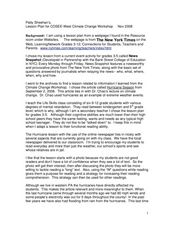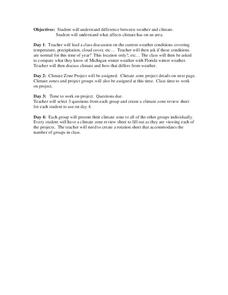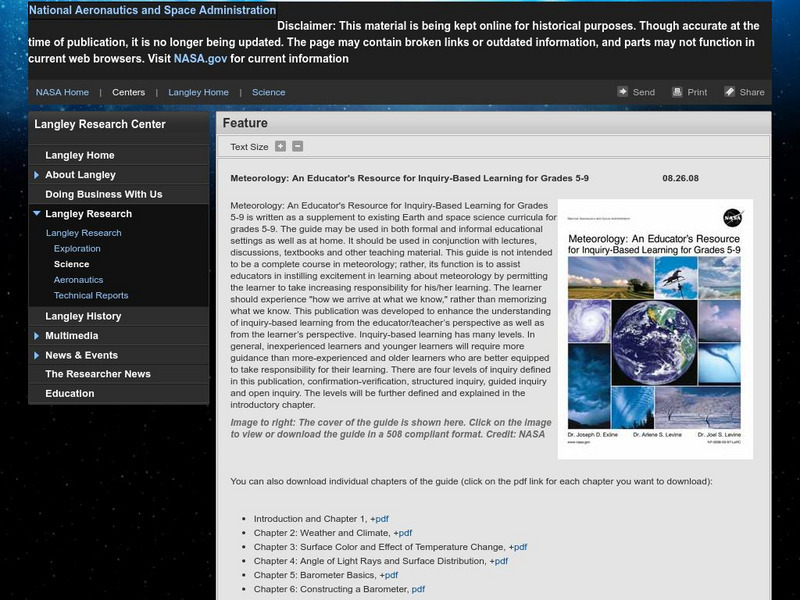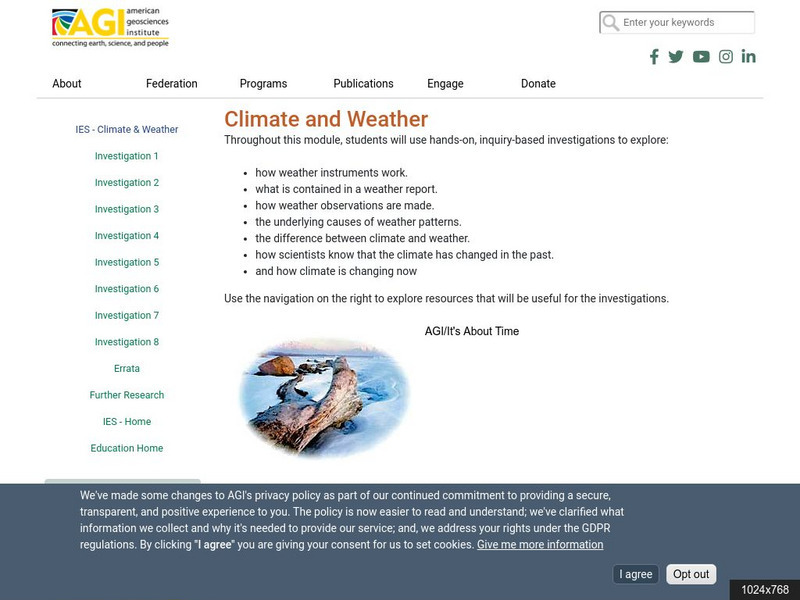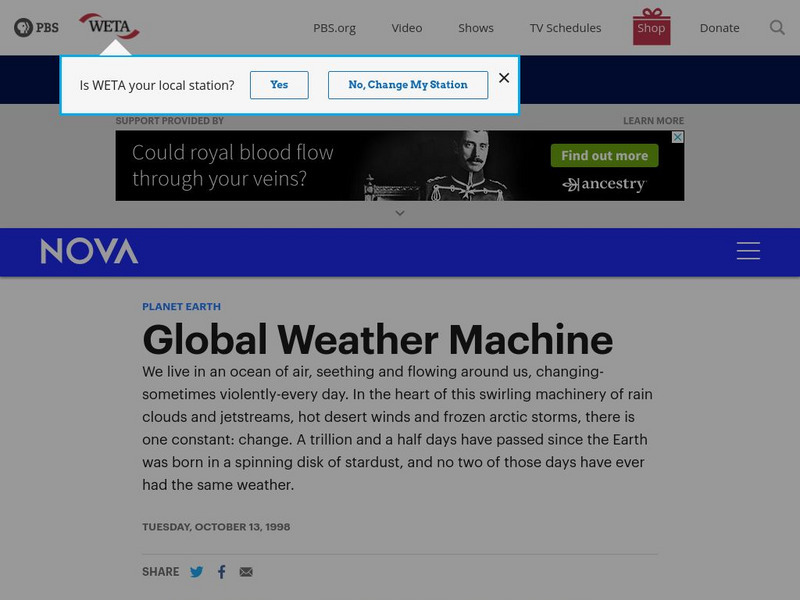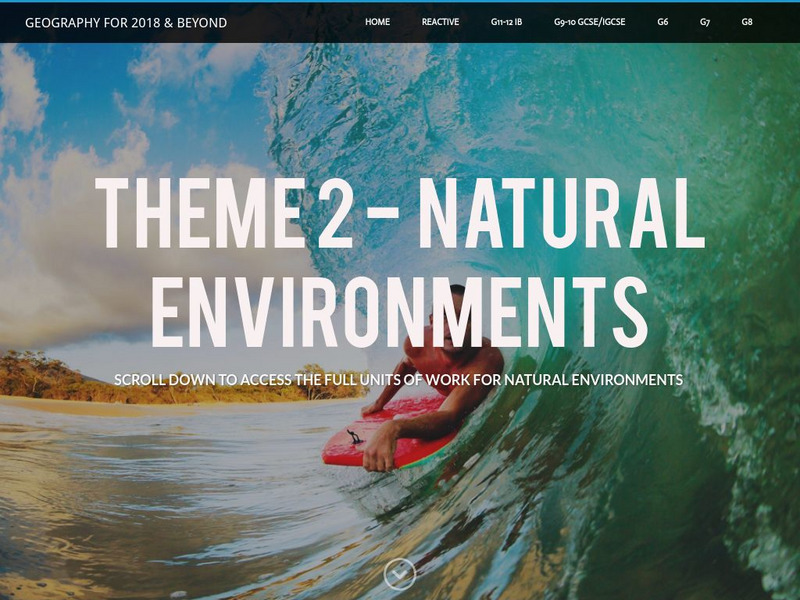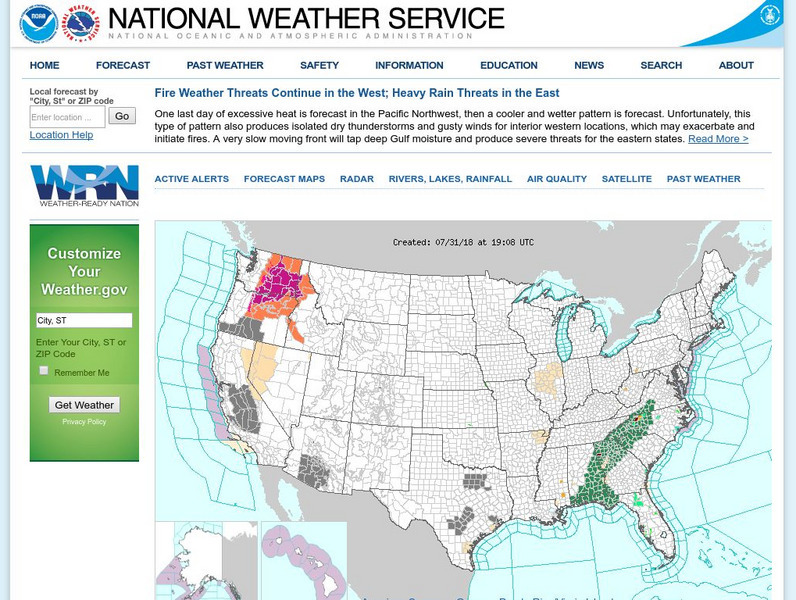Curated OER
Air Pollution: What's the Solution?
This air pollution worksheet provides a step-by-step process for gathering data about the ozone and weather. Amateur meteorologists enter data for 3 days including the air quality, the temperature, the wind speed, any particular events...
Curated OER
Drought in Your State
In this drought activity, learners study the "US Drought Monitor" and complete 8 short answer questions on the causes and effects of drought.
Curated OER
The Sun: Earth's Friend and Foe
Students study the structure and features of the sun. In this earth science lesson, students explain how the sun's energy drive the processes on Earth. They perform temperature conversions using appropriate equations.
Curated OER
Biomes
Seventh graders research about the climate and weather in different biome types. In this biology lesson, 7th graders create a brochure of their chosen biome using Microsoft Publisher. They present their work in class.
Curated OER
Canada's Arctic Barometer
Students research arctic climates. In this Web-quest investigation, students will identify Arctic climate changes, explain the effects of these changes, relate the changes to other regions, and write their findings in a letter format.
Curated OER
Wacky Weather
In this weather worksheet, students read a 3 page story about a girl who notices unusual weather patterns. Included in the story is information about climate, temperature, tides and wind. Students then answer 6 essay questions.
Curated OER
Making Clouds: Aerosol-Cloud Interactions in a Beaker
Students observe a teacher demo on how clouds form. In this earth science lesson, students discover how cloudiness affects relative humidity. They explain the scattering of light by clouds.
Curated OER
West Climate Change
Students read an internet article about hurricanes. In this hurricane lesson plan, students explain how they form and the damage they bring. They analyze the article and answer questions about it.
Curated OER
Weather & Climate
Sixth graders differentiate weather and climate. In this earth science lesson, 6th graders complete a KWL chart about the two. They complete a worksheet by identifying whether a certain statement describes weather or climate.
Curated OER
Weather Versus Climate
Students differentiate weather and climate. In this earth science lesson plan, students investigate the climate of a zone they chose. They create a presentation and share their findings with the class.
NASA
Nasa: Meteorology
Educator's resource guide to be used as a supplement to existing curriculum and to enhance the understanding of inquiry-based learning from both the educator/teacher's perspective as well as from the learner's perspective. Individual...
Center for Innovation in Engineering and Science Education, Stevens Institute of Technology
Ciese: Weather Scope: An Investigative Study of Weather and Climate
The activities in this comprehensive weather unit are designed for Grade 6 and up. Students will use real time data from around the world to conduct an investigation about weather and climate.
American Geosciences Institute
American Geosciences Institute: Climate and Weather
Eight hands-on lessons module in which students explore climate and weather. Inquiry-based investigations include observing weather, weather reporting, weather maps, weather satellites, causes of weather, and climate change.
PBS
Pbs Learning Media: Global Weather Machine
In this illustrated essay from NOVA Online, explore the cyclical process of weather creation and the effects of El Nino on the global weather system.
PBS
Pbs Learning Media: Nisqually Glacier at Mount Rainier
Observe the Nisqually Glacier at Mount Rainier in this video segment from NatureScene. [4:07]
University Corporation for Atmospheric Research
Ucar: Living in the Greenhouse
Check out the whole story of climate from ancient times through greenhouse gasses with this interactive resource.
Geographypods
Geographypods: Theme 2: Natural Environments
A rich collection of highly engaging learning modules on topics related to the natural environment. Covers four main areas - plate tectonics, forms and processes, weather and climate, and rainforest and desert. Within each of these,...
American Association for the Advancement of Science
Aaas: Project 2061: Topic: Weather and Climate I: Basic Elements
[Free Registration/Login Required] Create a science test that checks for student understanding in science, for common misconceptions, as well as for correct ideas. This is a list of key ideas related to Weather and Climate I: Basic...
PBS
Pbs: Are the World's Weather and Climate Changing?
What's going on with our weather? Learn about it in this lesson plan that examines the climate and weather patterns in the world today. It has a weather quiz and guidelines that help the young scholars understand weather changes...
NOAA
Noaa: Jetstream: Appendix
The National Weather Service presents this site of supplemental weather information. Materials include a glossary, acronyms, quizzes, lesson plans, and downloadable posters, booklets, weather wheels, etc.
NOAA
Noaa: National Weather Service: Jet Stream: Jet Stream Learning Lessons
Here's a comprehensive list of lesson plans offered by the National Weather Service covering the gamut of weather topics from the atmosphere to synoptic meterology. The plans include objectives, supplies necessary for the lesson, teacher...
National Weather Service
National Weather Service
Official United States Weather Bureau source for weather maps and forecasts. Contains forecasts, maps, warnings, data, current conditions, and storm warnings.
University Corporation for Atmospheric Research
Ucar: Learning Zone
This comprehensive, interactive site is loaded with information, activities, and stories about thunderstorms, lightning, and tornadoes. Find out how these weather systems are formed, how they impact our lives, and how they cause chaos.
Science Education Resource Center at Carleton College
Serc: Lab 3: Normal Climate Patterns
A lab experiment in a series of experiments that explores droughts. In this lab, students analyze data to determine what a normal climate should be.









